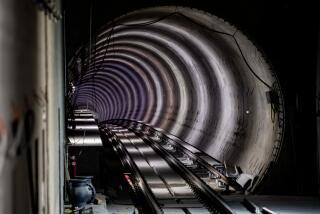Bringing the Tube Up to Speed
- Share via
LONDON — In London, the Tube is a card game played by 2.5 million travelers each day shunting around 267 stations on 249 miles of track. London’s Underground, that long beloved and currently bedeviled grande dame of a subway system, demands a card with a magnetic strip to get on and off.
Visitors sometimes are confused. Like Transport Minister George Young, who, bravely forsaking his chauffeur, rode the Tube to Parliament one day this week to announce government plans to privatize it.
Subway staff quickly rescued Young (he put his card into the ticket machine upside down), but opponents say his plans for the future of London’s Tube are as maladroit as his commuting savvy.
London Underground, one of the world’s largest and oldest urban rapid transit systems, is showing its age. Increasingly dogged by aging trains, tired tracks and worn-out infrastructure from signals to escalators, managers say the Underground needs nearly $2 billion just for the most urgently needed maintenance to keep the Tube running its average 20.5 mph.
Not with public money, says the righteously free-market Conservative government, whose ownership of the Underground has become an aberration: In 18 years, former Prime Minister Margaret Thatcher and her heirs have privatized ports, airlines, buses and the nation’s railways, along with telecommunications and utilities.
Now, 58 years after the system was nationalized, it is the turn of the Underground to return to private management, Prime Minister John Major says. There is an impressive list of potential bidders who see gold in them thar tunnels.
Like almost everything that happens in Britain now, the privatization scheme has become part of a mudslinging election campaign. Major, whose Tories trail rival Tony Blair’s Labor Party by 21 percentage points in the latest poll, must call an election by May.
Before announcing its plan, the government scrapped more than $1 billion from planned Tube financial support over the next three years, forcing cancellation of about 200 projects. But needed funds will arrive, the transport minister promised Parliament.
“I believe that the private sector will be able to deliver the results that passengers want, but more efficiently,” Young told lawmakers. The government says it could sell the entire system as a single business, sell operating rights to one or more of the 11 lines to different companies, or award franchises for fixed periods.
In all, analysts believe, the Underground could fetch in the neighborhood of $1 billion to $3 billion. In all eventualities, though, most of the money would be returned as subsidies to the new operators to bring the system back to high standards.
Promising that, with government oversight, service levels would be maintained, fares would not rise dramatically and current through tickets and popular all-day tickets would not change, Conservatives see their plan as a vote-getter. They promise to launch it this summer--if they are returned to office.
To which Labor replies: Not so fast.
Privatization would amount to an “abdication of responsibility,” said Blair, whose party favors a public-private partnership to repair Tube ills. Labor’s transport spokesman called privatization “bad for London, bad for passengers and bad for taxpayers.”
More to Read
Sign up for Essential California
The most important California stories and recommendations in your inbox every morning.
You may occasionally receive promotional content from the Los Angeles Times.








